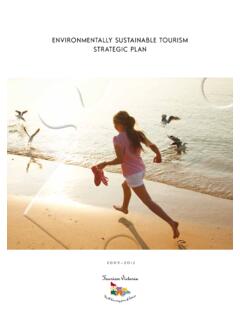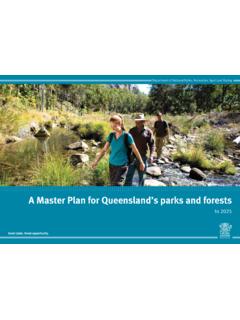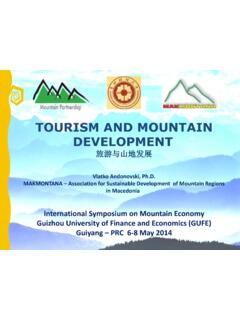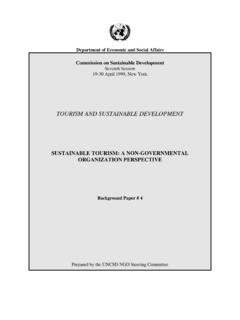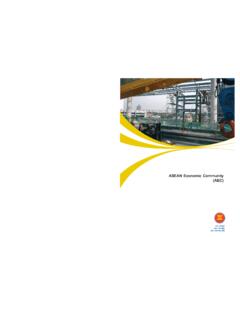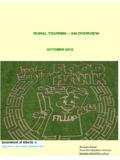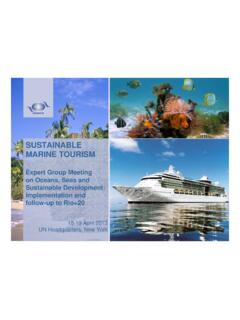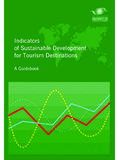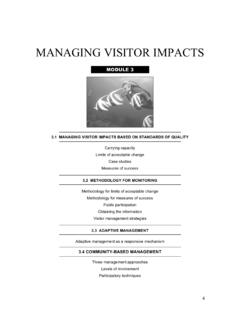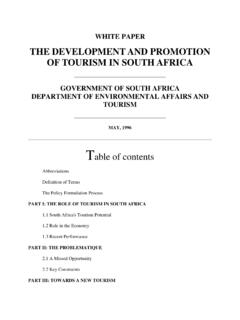Transcription of Tourism and the Great Barrier Reef - Ecotourism Australia
1 Tourism and the Great Barrier Reef Background Nested along 2,300km s of Australia s north-east coast, the Great Barrier Reef (GBR) is one of the world's greatest natural wonders. The GBR is littered with hundreds of coral islands, rich in biodiversity spawned by a vast array of endemic and endangered species. The GBR is a major drawcard for international and domestic visitors, generating major economic benefits and providing the financial lifeline of many local coastal communities. The global significance of the GBR is acknowledged across political boundaries, with its designation as a World Heritage Site in 1981.
2 Visitor trends? Data from Tourism Research Australia show that in the year ended June 2014, 1,728,000 domestic tourists have visited the GBR during their trip to Queensland. This represents an increas of 27% compared with the previous year. In addition, 2,244,217 international visitors have visited the GBR during their trip in Australia an increase of 6% compared with the previous year. Not all visitors who report having been to the GBR used a commercial Tourism operations. The Great Barrier Reef Marine Park Authority (GBRMPA) records visitation numbers from Tourism operators logbooks.
3 In the year ended June, GBRMPA recorded 2,017,604 visitors to the entire Marine Park. This represented a slight decrease of compared with the previous financial year. Most of the business (close to 40%) occurs in the months between October and January. About half of all commercial visitations into the Marine Park are recorded in the Cairns Planning Area (1,059,473 in the year ended June 2014). Tourism Australia supported a Sir David Attenborough three-part documentary on the past, present and future of the GBR. The series will be on air early in 2016 and be watched by hundreds of millions of viewers.
4 Already, research by Tourism Australia shows that 42% of international visitors rank the GBR as the most appealing tourist attraction in Australia , just after beaches and wildlife. Economic value? Visitors contribute directly to the day-to-day management of the Marine Park and in improving its long-term resilience through the environmental management charge (EMC). This charge is associated with most commercial activities, including Tourism operations, non-tourist charter operations, and facilities, operated under a permit issued by the GBRMPA. The EMC is collected per visitor ($6 per full-day, $3 per part-day visitor.)
5 In the financial year 2014, this amounted to a total of about $ million dollars. In addition, a Deloitte Access Economics model shows that, in 2012 visitors contributed $ billion in direct expenditure. Of this expenditure, $ billion was value added. In addition, Tourism provided 64,338 full time employees. The Wet tropics region recorded the highest level of modelled economic activity ($ billion in expenditure in 2012). World Heritage under pressure Since its inscription on the World Heritage List, UNESCO s World Heritage Committee has on several occasions questioned Australia about specific risks to the GBR.
6 In 2011, there were concerns raised about expansion of ports and industrial facilities. These concerns were heightened by the Outlook Report 2014 outlining declining trends in Reef health and citing major risks from climate change, poor water quality caused by runoff and coastal development, some aspects of fishing and the crown of thorns starfish outbreaks. Recognising the Australian and Queensland government actions to protect the Reef ( banning dredge disposal and port expansion) and increases in funding, the World Heritage Committee decided not to place the Reef on the World Heritage-in-danger List.
7 Instead they requested an update to their advisory body (the WH Centre) of progress with the Reef 2050 Long Term Sustainaiblity Plan in 2016 and inform the full Committee of the state of the conservation of the Reef in 2020. Tourism s contribution to monitoring? The Tourism industry is a major contributor to the environmental monitoring of the GBR. The Eye on the Reef program is an umbrella program that brings together four different types of assessment and monitoring activities. 1) Sightings network, 2) Rapid Monitoring, 3) Tourism Weekly Monitoring, and 4) Reef Health and Impact Surveys.
8 Since 2007, Reef users have recorded more than 9,000 sightings, by providing observations, photographs and videos. Free apps are available for download onto smart phones to report Reef sightings. Key Tourism groups - The Association of Marine Park Tourism Operators Pty Ltd (AMPTO) is the peak industry body for marine Tourism . - Tourism Reef Advisory Committee; supported by the GBRMPA's GM, Policy and Stewardship and Director, Tourism and Stewardship. - Tourism Tropical North Queensland, Towsnsville Enterprise, Capricorn Enterprise, Mackay Tourism , Gladstone Area Promotion & Development, Whitsundays Marketing and Development, Bundaberg North Burnett Tourism .
9 Data sources: Great Barrier Reef Marine Park Authority Tourism Research Australia : Deloitte Access Economics 2013, Economic contribution of the Great Barrier Reef, GBRMPA, Townsville. Tourism Australia : Great Barrier Reef research Snapshots Resident Perspectives on Protecting the GBR The growth of resource-sector related activities has triggered global media attention and raised questions about the management of the GBRWHA. To explore residents perceptions of the risks and impacts on the reef caused by the resources and Tourism sectors, 38 semi-structured in-depth interviews were undertaken in the Gladstone region.
10 Findings show high levels of place attachment and concern for the reef, but less support for reducing economic activity within the GBRWHA. A range of cognitive limitations and biases were identified. In addition, participants often expressed that existing legislation to protect the reef is sufficient but poorly implemented, with the complex governance structure leading to high levels of confusion in regards to who is actually responsible for protecting the reef. Source: Becken, S., McLennan C. & Moyle, B. (2014). World Heritage Area at Risk? Resident and Stakeholder Perceptions of the Great Barrier Reef in Gladstone, Australia .
